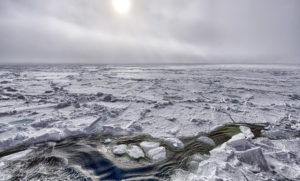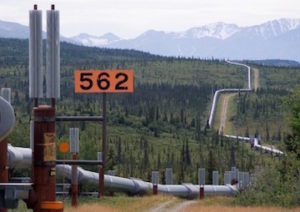Greenland’s Hidden Meltwater Lakes Store Trouble
Scientists find evidence of vast “storage tanks” of water deep below the melting Greenland ice sheet that could have a major effect on sea level rise. Sapphire-colored lakes and ponds of meltwater spring up in depressions on Greenland’s glaciers in summer but can quickly disappear deep underground. Photo by NASA via Wikimedia Commons
Sapphire-colored lakes and ponds of meltwater spring up in depressions on Greenland’s glaciers in summer but can quickly disappear deep underground. Photo by NASA via Wikimedia Commons
By Tim Radford, Climate News NetworkThis Creative Commons-licensed piece first appeared at Climate News Network.
LONDON — One small mystery that surrounds Greenland’s melting ice is a little closer to being solved as scientists in the US confirm that surface meltwater can drain all the way down to fill concealed lakes under the ice.
This means that atmospheric warming can reach thousands of metres below the ice sheet — warming the glacial base and potentially increasing its rate of flow.
One group, led by geologist Michael Willis, of Cornell University, and another team led by glaciologist Ian Howat, of Ohio State University, report in two different journals on separate but related studies of Greenland’s plumbing system: what happens to meltwater.
The ice sheet of Greenland adds up to about four-fifths of the mass of the vast frozen island, and there is evidence that, as a consequence of global warming, the rate of melting has begun to accelerate.
Measurable difference
This has already begun to make a measureable difference to global sea levels, and were the entire island to shed its burden of ice — a process that would take a considerable time — then sea levels would rise by seven metres or more.
So what exactly happens to the water that forms on the surface and collects in lakes each summer, and how much of it gets into the sea, has become an important but perplexing problem. Surface lakes are now appearing much further inland, and at higher altitudes, than recorded in the past.
Dr Howat and his colleagues report in The Cryosphere that they measured a two kilometre-wide depression 70 metres deep in the icecap of southwest Greenland, which they then identified as “the first direct evidence for concentrated long-term storage and sudden release of meltwater at the bed”.
The slumped crater suggested a holding capacity of more than 30 million cubic metres of water, which had suddenly drained away.
“If we are going to do something to mitigate sea level rise, we need to do it earlier rather than later”
“The fact that our lake appears to have been stable for at least several decades, and then drained in a matter of weeks — or less — after a few very hot summers, may signal a fundamental change happening to the ice sheet,” Dr Howat said.
The Cornell team worked in northeast Greenland, and in 2011 found a collapsed basin 70 metres deep. Dr Willis and colleagues report in Nature journal that between 2011 and 2014 they watched as summer meltwater made its way down fissures in the depression and refilled a lake basin at the base of the icecap. When this in turn emptied, the researchers calculated that the flow from the subglacial lake was at a rate of 215 cubic metres per second.
“We’re seeing surface meltwater make its way to the base of the ice where it can get trapped and stored at the boundary between the bedrock beneath the ice sheet and the ice itself,” they say.
“As the lake beneath the ice fills with surface meltwater, the heat released by this trapped meltwater can soften surrounding ice, which may eventually cause an increase in ice flow.”
Glacial flow
The researchers do not yet know whether the draining water is increasing glacial flow, and nor can they be sure how many such depressions in the Greenland ice mask buried meltwater storage tanks.
But melting of glacial ice is likely to accelerate anyway, according to new research in the journal Climate Dynamics.
Earth scientist Patrick Applegate, of Penn State University, reports that computer models confirm that the more temperatures increase, the faster the ice will melt.
Were all Greenland’s ice to melt, sea levels would rise catastrophically. At least one billion people live on coasts and estuaries vulnerable to a mere one metre rise.
The Arctic is already the fastest warming place in the northern hemisphere, and the Penn State scientists wanted to see how present warming could play back into future warming. Engineers call this positive feedback.
“If we are going to do something to mitigate sea level rise, we need to do it earlier rather than later,” Dr Applegate said. “The longer we wait, the more rapidly the changes will take place and the more difficult it will be to change.”
Your support matters…Independent journalism is under threat and overshadowed by heavily funded mainstream media.
You can help level the playing field. Become a member.
Your tax-deductible contribution keeps us digging beneath the headlines to give you thought-provoking, investigative reporting and analysis that unearths what's really happening- without compromise.
Give today to support our courageous, independent journalists.






You need to be a supporter to comment.
There are currently no responses to this article.
Be the first to respond.